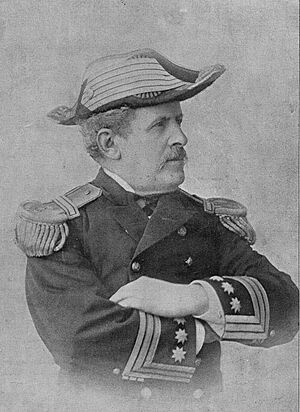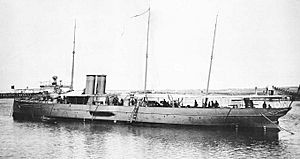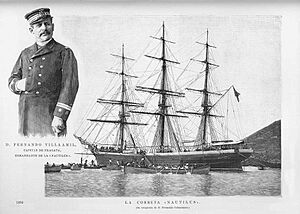Fernando Villaamil facts for kids
Fernando Villaamil Fernández-Cueto (born November 23, 1845 – died July 3, 1898) was a brave Spanish naval officer. He was known around the world for his skills. He also invented the destroyer warship. He sadly died fighting in the Battle of Santiago de Cuba during the Spanish–American War. He was the highest-ranking Spanish officer to die in that war.
Contents
Fernando Villaamil was born in Serantes, a small town near Castropol in Asturias, northern Spain. His home was very close to the Cantabrian Sea. His family was once wealthy, but his father lost almost everything. This made Fernando feel both love and anger for his home region throughout his life.
In 1861, Fernando joined the Spanish Navy at the Colegio Naval de San Fernando. A year later, he became a midshipman on the frigate Esperanza. This was the first of many warships he would serve on.
He later served in the Philippines and Cuba. These were the last parts of the Spanish Empire. In 1873, he returned to Spain. He became a teacher at the Naval School in Ferrol. During these years, Villaamil studied and wrote a lot. He became one of the most respected officers in the Spanish Navy.
The First Destroyer: Destructor
In 1884, Villaamil became a high-ranking officer in the Ministry of the Navy. He decided to design a new type of warship. This ship would be built to fight the small, fast torpedo boats that were new at the time.
He shared his ideas with the Minister of the Navy, Manuel Pezuela. The minister agreed with him. Villaamil chose the British shipyards of James & George Thompson in Clydebank to build the new ship. Construction began in late 1885.
Villaamil went to Great Britain to watch the building process. He also studied how British naval shipyards worked. On January 19, 1887, the Destructor was officially given to the Spanish Navy. This was the world's first torpedo boat destroyer. Everyone in the European navy community was very excited about it.
On January 24, the Destructor left Falmouth for Vigo, Spain. Villaamil was in command. The ship had reached 22.5 knots (41.7 km/h) during its tests. Twenty-four hours later, it reached the Spanish coast. It sailed at 18 knots (33 km/h) through a stormy Bay of Biscay.
This journey proved that the ship was strong enough for rough seas. Villaamil was very proud. Because the Destructor was such a success, Villaamil's reputation grew in Spain and around the world.
Sailing Around the World on the Nautilus
Villaamil believed that sailing across oceans was the best way to train young Navy officers. In 1892, he became the commander of the corvette Nautilus. He used the 400th anniversary of America's discovery to get approval for a training trip around the world. This journey would involve sailing around the three Great Capes.
On November 30, 1892, the Nautilus left Ferrol. It sailed around Cape Agulhas and Cape Leeuwin. It passed through Bass and Cook straits. Then it rounded Cape Horn and went to New York City. After sailing forty thousand miles, the ship returned to Spain on July 16, 1894, in San Sebastián.
When they arrived, the sailors saw a royal boat approaching. It was the Regent Queen and her son, the young King Alfonso XIII. They came to welcome Villaamil and the entire Nautilus crew.
This world trip made Villaamil even more popular. He wrote a great book about the journey. In it, he shared not only what happened on the trip but also his thoughts on many things he saw. He wrote about the differences between British and Spanish colonies. He also visited the Cramp shipyards in Philadelphia in May 1894. He saw many warships being built there. He wrote that the United States was spending a lot of money on new warships. He did not know that these ships would play a part in his own destiny just four years later.
The Spanish–American War
In the years that followed, Villaamil and other smart officers tried to warn Spain about its Navy's weaknesses.
Then, things moved very fast. Tension with the United States grew quickly. On February 16, 1898, the day after the USS Maine exploded in Havana, Villaamil was put in charge of the First Division of torpedo boats and destroyers.
Many people in Spain wrongly believed their navy was unbeatable. The government decided to send a whole fleet, led by Admiral Pascual Cervera, across the Atlantic. Both Cervera and other Spanish Navy officers advised against this.
Villaamil and his First Division left Cadiz on March 13. On April 18, they met Admiral Cervera's fleet in the Cape Verde islands.
A month later, on April 24, the United States declared war on Spain. Cervera was ordered to go to the Antilles. Villaamil's Division was split up. His destroyers joined Cervera's fleet, and the torpedo boats went back to Spain.
This left Villaamil without a specific job. He could have gone back to Spain. But he chose to stay with his fellow sailors. He knew the fleet was heading for disaster because it was not ready for war.
Villaamil disagreed with the Spanish Government's poor war plans. He also disagreed with Cervera's passive strategy. Villaamil wanted to spread out the fleet and attack quickly. He even offered to lead a daring attack on New York with his destroyers. But his ideas were not accepted.
So, Villaamil had to stay with the fleet in the bay of Santiago de Cuba.
Finally, on July 3, the entire Spanish fleet sailed out of the narrow bay. The ships came out one by one. They had no chance of winning against the US fleet.
The Final Battle
Villaamil was killed on board one of his destroyers, the Furor. Francisco Arderius, an officer on the ship, described Villaamil's death:
After several gunshots caused huge damage and many deaths, Captain Villaamil went up to the front gun platform. As I was about to follow him, a grenade exploded there. I only saw a lot of blood coming down. Soon after we jumped overboard, the ship, already on fire, sank with Don Fernando Villaamil's lifeless body.
See also
 In Spanish: Fernando Villaamil para niños
In Spanish: Fernando Villaamil para niños





